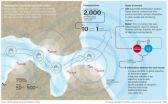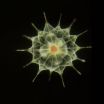(Press-News.org) Jerusalem, October 4, 2010 – Researchers at the Hebrew University of Jerusalem have discovered a group of substances in the body that play a key role in controlling bone density, and on this basis they have begun development of a drug for prevention and treatment of osteoporosis and other bone disorders.
The findings of the Hebrew University researchers have just been published in the American journal PNAS (Proceedings of the National Academy of Sciences).
The research group working on the project is headed by Prof. Itai Bab of the Bone Laboratory and Prof. Raphael Mechoulam of the Institute of Drug Research at the Hebrew University, and includes post-doctoral fellow Reem Smoum and doctoral students Gary Millman, Orr Ofek, Alon Bajayo, Joseph Tam, Vardit Kram and associates from the United States.
Osteoporosis is the most widespread degenerative disease in the Western world and is expressed in the loss of bone mass and the weakening of bone structure, contributing to frequent bone fractures, disability and even death. The loss of bone mass in osteoporosis is caused by internal destruction of the bone tissue. With age, the quantity of bone tissue that is lost is greater than that which is created, which leads to the decrease in bone density.
In their current research, the researchers found that the bone cells produce a series of substances composed of fatty acids and amino acids called "acyl amides." They then analyzed their precise chemical composition, created synthetic versions of them, and examined their effect on bone cell cultures.
In experiments on mice, they discovered that one of the compounds in the group of synthetic materials, oleoyl serine, increased bone density in both healthy and osteoporotic mice. They also found that the osteoporotic mice were actually missing the oleoyl serine in their bones. These findings, say the researchers, can serve as the basis for new drugs that can both prevent bone loss and boost bone formation and in this way reverse loss of bone tissue in osteoporosis patients.
Development of such a drug has begun in the laboratories of Prof. Mechoulam and Prof. Bab. Yissum, the technology transfer company of the Hebrew University, has submitted a patent application based on their work and is seeking a commercial partner for further development.
Prof. Mechoulam expressed confidence that their work showing bone mass accumulation would lead soon to the development of an effective osteoporosis drug. Drugs in use until now have worked to prevent further bone loss or to encourage bone formation, but none of them are able to accomplish both functions together as this new formula can do, said Prof. Bab.
The researchers noted that research in this field until now has been based primarily on proteins and genetics. Now, the Hebrew University researchers say, they have opened a new approach, called "skeletal lipidomics" based on the examination of substances in the skeleton containing fatty acids and amino acids. This has great significance in understanding the regulation of metabolism in bone and in other body tissues, they say.
INFORMATION:
The research has been supported by the United States-Israel Binational Science Foundation and also by a grant from the US National Institutes of Health.
Hebrew University research holds promise for development of new osteoporosis drug
2010-10-05
ELSE PRESS RELEASES FROM THIS DATE:
Disappearing glaciers enhanced biodiversity
2010-10-05
Biodiversity decreases towards the poles almost everywhere in the world, except along the South American Pacific coast. Investigating fossil clams and snails Steffen Kiel and Sven Nielsen at the Christian-Albrechts-Universität zu Kiel (CAU) could show that this unusual pattern originated at the end of the last ice age, 20.000 to 100.000 years ago. The retreating glaciers created a mosaic landscape of countless islands, bays and fiords in which new species developed rapidly – geologically speaking. The ancestors of the species survived the ice age in the warmer Chilean north.
The ...
A step toward lead-free electronics
2010-10-05
Research published today by materials engineers from the University of Leeds could help pave the way towards 100% lead-free electronics.
The work, carried out at the UK's synchrotron facility, Diamond Light Source, reveals the potential of a new manmade material to replace lead-based ceramics in countless electronic devices, ranging from inkjet printers and digital cameras to hospital ultrasound scanners and diesel fuel injectors.
European regulations now bar the use of most lead-containing materials in electronic and electrical devices. Ceramic crystals known as 'piezoelectrics' ...
Ancient Colorado river flowed backwards
2010-10-05
Palo Alto, CA—Geologists have found evidence that some 55 million years ago a river as big as the modern Colorado flowed through Arizona into Utah in the opposite direction from the present-day river. Writing in the October issue of the journal Geology, they have named this ancient northeastward-flowing river the California River, after its inferred source in the Mojave region of southern California.
Lead author Steven Davis, a post-doctoral researcher in the Department of Global Ecology at the Carnegie Institution, and his colleagues* discovered the ancient river system ...
An eye for an eye
2010-10-05
Revenge cuts both ways in the Israeli-Palestinian conflict. Scientists of the University of Zurich, the Massachusetts Institute of Technology, and Tel Aviv and Quinnipiaq Universities show that attacks by either side lead to violent retaliation from the other. Both Israelis and Palestinians may underestimate their own role in perpetuating the conflict.
A team of scientists from the University of Zurich, the Massachusetts Institute of Technology, and Tel Aviv and Quinnipiaq Universities have found that attacks by both Israel and Palestinians lead to violent retaliation ...
When docs counsel weight loss, it's style that makes a difference
2010-10-05
DURHAM, N.C. – Most doctors are spending a good deal of time counseling their patients about diet and weight loss, but for the most part, it isn't making any difference, according to a new study appearing in the American Journal of Preventive Medicine.
Duke University Medical Center researchers recorded the conversations between 40 primary care physicians and 461 of their overweight or obese patients over an 18-month period. Investigators didn't tell them what they were listening for – only that they wanted to record the encounters to see how doctors talked about health. ...
Researchers find possible biomarker to identify seizure-related stress
2010-10-05
PROVIDENCE, RI -- New research from Rhode Island Hospital found that reduced levels of brain-derived neurotrophic factor (BDNF), a protein in the brain that encourages growth of neurons, may be a trait marker for individuals with psychogenic non-epileptic seizures (PNES) (seizures that are psychological in origin). The findings are published in the October 4, 2010, issue of Neurology, the medical journal of the American Academy of Neurology.
Past studies have shown decreased levels of BDNF in the serum of patients with psychiatric disorders such as major depressive disorder ...
An intelligent system for maritime surveillance has been created
2010-10-05
The system has been designed by scientists from this Madrid university for Núcleo CC, a company which develops surveillance systems for the maritime and aeronautic sectors. The first prototype will be used in the near future in Cape Verde (Africa). Two types of sensors have been deployed there: a set of radars and a series of AIS (Automatic Identification System), which allow ships to communicate their position and give other relevant data on their location and characteristics. These two types of sensors offer complementary data which can be fused in order to obtain better ...
MBL scientists reveal findings of World Ocean Microbe Census
2010-10-05
LONDON, UK—After a decade of joint work and scientific adventure, marine explorers from more than 80 countries, including six scientists from the Marine Biological Laboratory (MBL), today delivered the first global Census of Marine Life revealing what, where, and how much lives and hides in the world's oceans. In one of the largest scientific collaborations ever conducted, more than 2,700 scientists spent over 9,000 days at sea on more than 540 expeditions gathering the data.
As a result of these efforts the scientists discovered that there may be up to 1 billion kinds ...
New report examines university management of intellectual property
2010-10-05
WASHINGTON — The system put in place by the Bayh-Dole Act of 1980 -- which gives universities significant control over intellectual property associated with the results of federally funded research at their institutions – has been more effective than the pre-1980 system in making research advances available to the public and spurring innovation, says a new report from the National Research Council. Nevertheless, the current system needs improvement, said the committee that wrote the report.
"The public investment in research universities has led to a great deal of new ...
Surprise: Scientists discover that inflammation helps to heal wounds
2010-10-05
A new research study published in The FASEB Journal (http://www.fasebj.org) may change how sports injuries involving muscle tissue are treated, as well as how much patient monitoring is necessary when potent anti-inflammatory drugs are prescribed for a long time. That's because the study shows for the first time that inflammation actually helps to heal damaged muscle tissue, turning conventional wisdom on its head that inflammation must be largely controlled to encourage healing. These findings could lead to new therapies for acute muscle injuries caused by trauma, chemicals, ...



